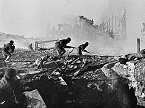M60A3TTS wrote: Fri Oct 17, 2025 3:00 pm
Armor production. Decent number of vehicles. Didn't touch the flame tanks much. For the individual who complained about not having King Tigers in his heavy tank battalions in another thread, note the Soviets share the same problem, with an unused pool of KV-85s and IS-1s. The new IS-2s would have sat as well. Meanwhile the KV-1S losses are replaced by older KV-1 tanks.
Just build the Heavy Tank Regiments as was suggested and you will be able to use the new Heavy tanks in no time.

M60A3TTS wrote: Fri Oct 17, 2025 3:00 pm
Here are half my tank corps, none of which are guards. Totally messed up here, they could have all been guards had it been managed properly. As it was, jubjub fought in such a way any overly exposed tank corps was decimated. It was only later I tried to cover them with rifle corps. I would have been better off sticking to more brigades as support units.
Those Tank Corps's win rates look fine, you are just missing some wins to increase the chance/roll each turn to get them to become Guards.
1943 a MOT needs 12+1+rnd(12) to become Guards. Not sure if the rnd(12) can ever be 0?! So all your 10-13 wins are just missing few more wins to be eligible. The first two must just be bad luck. Or are your Tank Guards percentages maxed out already?
M60A3TTS wrote: Fri Oct 17, 2025 3:00 pm
Active aircraft pools. There are huge stockpiles of tac bombers and enormously wasted production of U-2VS. Not enough formations even to throw vast quantities of U2-VS' away. Fighters are what matter in dictating how much airpower can influence battles. Also, lack of vehicles and manpower made keeping the VVS at full strength on the map was starting to be a challenge.
Any reason why you never used GS from ~mid 1942 onwards?
I have seen defensive battles with ~20 Axis Fighters intercepting ~30 Biplane TacB in 1941 (with no escort) and the TacB still hitting lots of targets on ground before getting shot down, so it's not all bound to Fighters, that's the GG RNG we love, no?

Imo there's no reason to not have defensive GS as Soviets. Pilots and planes are there, just use them. They won't turn every battle but they are part of the attritional war, if each plane gets 6-10 Germans KIA on average, that's ~100k Germans dead with your Pool and many more Disabled (of which another 33% die), this makes more elements needing to be rebuild at the frontline (consuming freight - altough may not matter in 1943 that much anymore) and reducing EXP of that Ground elements (which otherwise basically does not happen when Germans get reduced NM, so you need to "kill the EXP"). It may also help with untis MOR, the disrupted Elements gain fatigue and then Leaders may fail some more fatigue rolls which may reduce the Division's MOR - which again otherwise basically does not happen by itself.
A plane on average may need like ~16Men for service, let's say it is 20. If you have 100 Bombers of which all die and every killing 6 Germans (average), that's 2000Men killing 600Germans, not sure how that would not make sense to invest in. The 2000Men stay alive and noone cares about the pilots.
Such K:D rates (even if the 2000 would die) is what the Ground forces can only dream off.
 EDIT:
EDIT: For your case, 5000 planes on MAP x 20Men = 100k Air Personell needed, this would equal not even 2% of your total MAP Manpower. Even if my math is off and it requires twice as much it'd still be worth it imo.
M60A3TTS wrote: Fri Oct 17, 2025 3:00 pm
Compare how two groups of artillery perform in a Soviet assault on a Level 3 fort. Here, 32 German M18 Howitzers had about 25% more HE hits than 1,324 Soviet artillery pieces.
Some things never change.

...probably still at 75+ MOREX and with 100CPP.





















